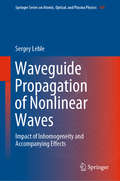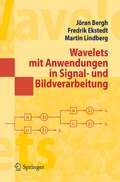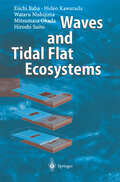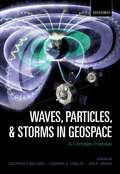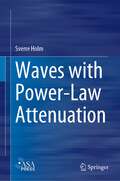- Table View
- List View
Waveguide Propagation of Nonlinear Waves: Impact of Inhomogeneity and Accompanying Effects (Springer Series on Atomic, Optical, and Plasma Physics #109)
by Sergey LebleThis book addresses the peculiarities of nonlinear wave propagation in waveguides and explains how the stratification depends on the waveguide and confinement. An example of this is an optical fibre that does not allow light to pass through a density jump. The book also discusses propagation in the nonlinear regime, which is characterized by a specific waveform and amplitude, to demonstrate so-called solitonic behaviour. In this case, a wave may be strongly localized, and propagates with a weak change in shape. In the waveguide case there are additional contributions of dispersion originating from boundary or asymptotic conditions.Offering concrete guidance on solving application problems, this essentially (more than twice) expanded second edition includes various aspects of guided propagation of nonlinear waves as well as new topics like solitonic behaviour of one-mode and multi-mode excitation and propagation and plasma waveguides, propagation peculiarities of electromagnetic waves in metamaterials, new types of dispersion, dissipation, electromagnetic waveguides, planetary waves and plasma waves interaction.The key feature of the solitonic behaviour is based on Coupled KdV and Coupled NS systems. The systems are derived in this book and solved numerically with the proof of stability and convergence. The domain wall dynamics of ferromagnetic microwaveguides and Bloch waves in nano-waveguides are also included with some problems of magnetic momentum and charge transport.
Wavelet Analysis in Civil Engineering
by Pranesh ChatterjeeWavelets as a Powerful Signal Processing Tool The principles of wavelets can be applied to a range of problems in civil engineering structures, such as earthquake-induced vibration analysis, bridge vibrations, and damage identification. This book is particularly useful for graduate students and researchers in vibration analysis, especially those dealing with random vibrations. Wavelet Analysis in Civil Engineering explains the importance of wavelets in analyzing nonstationarities in ground motions. The example of a tank is considered to develop the problem and the model (based on linear assumptions) and several case studies are explored—fixed base, flexible base, lateral and rocking motions of foundations, with and without fluid—to explain how to account for ground motion nonstationarities. Bridge vibrations caused by vehicle passage are explored, as is structural damage identification. Wavelet analytic techniques starting from single degree of freedom systems to multiple degree of freedom systems are set out and detailed solutions of more complicated problems involving soil and fluid interactions are presented. Separate chapters have been devoted to explaining the basic principles of the wavelet-based random nonstationary vibration analysis of nonlinear systems, including probabilistic analysis. Comprised of seven chapters, this text: Introduces the concept and utility of wavelet transform Describes the discretization of ground motions using wavelet coefficients Explains how to characterize nonstationary ground motions using statistical functionals of wavelet coefficients of seismic accelerations Develops the formulation of a linear single-degree-of-freedom system Shows stepwise development of the formulation of a structure idealized as a linear multi-degree-of-freedom system in terms of wavelet coefficients Defines wavelet domain formulation of a nonlinear single-degree-of-freedom system Introduces the concept of probability in wavelet-based theoretical formulation of a nonlinear two-degree-of-freedom system Covers a variety of case studies highlighting diverse applications Wavelet Analysis in Civil Engineering explains the importance of wavelets in terms of non-stationarities of ground motions, explores the application of wavelet analytic techniques, and is an excellent resource for users addressing wavelets for the first time.
Wavelet Theory and Application: A Special Issue of the Journal of Mathematical Imaging and Vision
by Andrew LaineFinally, Moulin considers the problem of forming radar images under a diffuse-target statistical model. His estimation approach includes application of the maximum-likelihood principle and a regularization procedure based on wavelet representations. In addition, he shows that the radar imaging problem can be seen as a problem of inference on the wavelet coefficients of an image corrupted by additive noise. The aim of this special issue is to provide a forum in which researchers from the fields of mathematics, computer science, and electrical engineering who work on problems of significance to computer vision can better understand each other. I hope that the papers included in this special issue will provide a clearer picture of the role of wavelet transforms and the principles of multiresolution analysis. I wish to thank many people for their contributions and assistance in this project: Gerhard Ritter, the Editor-in-Chief of the Journal of Mathematical Imaging and Vision, who invited me to organize this issue and who provided patient guidance; the researchers who submitted papers for consideration and others who have contributed to the explosion of growth in this area; the reviewers, who provided careful and thoughtful evaluations in a timely fashion; and, finally, from these efforts, the authors of the papers selected for publication in the special issue. Andrew Laine Guest Editor Center for Computer Vision and Visualization Department of Computer and Information Sciences University of Florida Journal of Mathematical Imaging and Vision, 3, 7-38 (1993). © Kluwer Academic Publishers. Manufactured in The Netherlands.
Wavelets: Time-Frequency Methods and Phase Space (inverse problems and theoretical imaging)
by Jean-Michel Combes Alexander Grossmann Philippe TchamitchianThe last two subjects mentioned in the title "Wavelets" are so well established that they do not need any explanations. The first is related to them, but a short introduction is appropriate since the concept of wavelets emerged fairly recently. Roughly speaking, a wavelet decomposition is an expansion of an arbitrary function into smooth localized contributions labeled by a scale and a position pa rameter. Many of the ideas and techniques related to such expansions have existed for a long time and are widely used in mathematical analysis, theoretical physics and engineering. However, the rate of progress increased significantly when it was realized that these ideas could give rise to straightforward calculational methods applicable to different fields. The interdisciplinary structure (R.c.P. "Ondelettes") of the C.N .R.S. and help from the Societe Nationale Elf-Aquitaine greatly fostered these developments. This conference was held at the Centre National de Rencontres Mathematiques (C.I.R.M) in Marseille from December 14 to 18, 1987 and brought together an interdisciplinary mix of participants. We hope that these proceedings will convey to the reader some of the excitement and flavor of the meeting.
Wavelets: Time-Frequency Methods and Phase Space Proceedings of the International Conference, Marseille, France, December 14–18, 1987 (inverse problems and theoretical imaging)
by Jean-Michel Combes Alexander Grossmann Philippe TchamitchianThe last two subjects mentioned in the title "Wavelets, Time Frequency Methods and Phase Space" are so well established that they do not need any explanations. The first is related to them, but a short introduction is appropriate since the concept of wavelets emerged fairly recently. Roughly speaking, a wavelet decomposition is an expansion of an arbitrary function into smooth localized contributions labeled by a scale and a position pa rameter. Many of the ideas and techniques related to such expansions have existed for a long time and are widely used in mathematical analysis, theoretical physics and engineering. However, the rate of progress increased significantly when it was realized that these ideas could give rise to straightforward calculational methods applicable to different fields. The interdisciplinary structure (R.C.P. "Ondelettes") of the C.N.R.S. and help from the Societe Nationale Elf-Aquitaine greatly fostered these developments. The conference, the proceedings of which are contained in this volume, was held at the Centre National de Rencontres Mathematiques (C.N.R.M) in Marseille from December 14-18, 1987 and bought together an interdisciplinary mix of par ticipants. We hope that these proceedings will convey to the reader some of the excitement and flavor of the meeting.
Wavelets and Fractals in Earth System Sciences
by E. Chandrasekhar V. P. Dimri V. M. GadreThe subject of wavelet analysis and fractal analysis is fast developing and has drawn a great deal of attention in varied disciplines of science and engineering. Over the past couple of decades, wavelets, multiresolution, and multifractal analyses have been formalized into a thorough mathematical framework and have found a variety of applications w
Wavelets and Signal Processing: An Application-Based Introduction
by Hans-Georg StarkProfessor Noubari's recommendation: "Professor Starks book provides an effective entry into the field for engineering students who have little or no prior knowledge of this important subject. Avaibility of collection of computer codes and mfiles in combination with topics of the book, makes the book highly valuable to enhance student learning of the subject matter."
Wavelets and Their Applications (Nato Science Series C: #442)
by J. S. Byrnes Kathryn A. Hargreaves Karl BerryIt is probably true quite generally that in the history of human thinking the most fruitful developments frequently take place at those points where two different lines of thought meet. Hence, if they actually meet, that is, if they are at least so much related to each other that a real interaction can take place, then one may hope that new and interesting developments may follow. Werner Heisenberg This volume contains papers presented at the August 1992 NATO Advanced Study Institute on Wavelets and Their Applications. The conference was held at the beautiful Il Ciocco resort near Lucca, in the glorious Tuscany region of northern Italy. Once again we gathered at this idyllic spot to explore and extend the reciprocity between mathematics and engineering. The dynamic interaction between world-renowned scientists from the usu ally disparate communities of pure mathematicians and applied scientists, which occurred at our 1989 and 1991 ASI's, continued at this meeting. Wavelet theory and technology is in an important growth stage at which theoretical and practical results are being compared with existing methods. There have been spectacular wavelet successes and sobering comparisons with traditional ideas-but still there is a wide expanse of scientific problems to explore. Since these problems lie at the forefront of both pure mathematics and applied science, our NATO ASI was especially pertinent at this time.
Wavelets mit Anwendungen in Signal- und Bildverarbeitung (Masterclass)
by Jöran Bergh Fredrik Ekstedt Martin LindbergGelungene Kombination aus Monografie und Handbuch: Sie spricht Leser an, die sich mit den grundlegenden mathematischen Ideen und Techniken der Wavelets vertraut machen und zugleich wissen möchten, wie die Theorie derzeit angewendet wird. Das Buch setzt Kenntnisse über Anwendungen der linearen Algebra, der Fourierreihen und Fourierschen Integrale voraus, weitere Kenntnisse sind ebenso wünschenswert. Eine allzu übertriebene Präzision würde jedoch zu hohe Anforderungen an die Leser stellen. Die Lösung des Dilemmas ist ein Kompromiss: Die Autoren verzichten auf einige mathematische Details und verweisen stattdessen auf weiterführende Literatur.
Waves Across the South: A New History Of Revolution And Empire
by Sujit Sivasundaram‘Helps re-centre how we look at the world and opens up new perspectives on how we can look at regions, peoples and places that have been left to one side of traditional histories for far too long’ PETER FRANKOPAN
Waves and Compressible Flow (Texts in Applied Mathematics #47)
by Hilary Ockendon John R. OckendonNow in its second edition, this book continues to give readers a broad mathematical basis for modelling and understanding the wide range of wave phenomena encountered in modern applications. New and expanded material includes topics such as elastoplastic waves and waves in plasmas, as well as new exercises. Comprehensive collections of models are used to illustrate the underpinning mathematical methodologies, which include the basic ideas of the relevant partial differential equations, characteristics, ray theory, asymptotic analysis, dispersion, shock waves, and weak solutions. Although the main focus is on compressible fluid flow, the authors show how intimately gasdynamic waves are related to wave phenomena in many other areas of physical science. Special emphasis is placed on the development of physical intuition to supplement and reinforce analytical thinking. Each chapter includes a complete set of carefully prepared exercises, making this a suitable textbook for students in applied mathematics, engineering, and other physical sciences. Reviews of the first edition:"This book … is an introduction to the theory of linear and nonlinear waves in fluids, including the theory of shock waves. … is extraordinarily accurate and free of misprints … . I enjoyed reading this book. … most attractive and enticing appearance, and I’m certain that many readers who browse through it will wish to buy a copy. The exercises … are excellent. … A beginner who worked through these exercises would not only enjoy himself or herself, but would rapidly acquire mastery of techniques used…in JFM and many other journals…" (C. J. Chapman, Journal of Fluid Mechanics, Vol. 521, 2004) "The book targets a readership of final year undergraduates and first year graduates in applied mathematics. In the reviewer’s opinion, it is very well designed to catch the student’s interest … while every chapter displays essential features in some important area of fluid dynamics. Additionally, students may practice by solving 91 exercises. This volume is mainly devoted to inviscid flows. … The book is very well written." (Denis Serre, Mathematical Reviews, 2004)
Waves and Nonlinear Processes in Hydrodynamics (Fluid Mechanics and Its Applications #34)
by John Grue Bjø Gjevik Jan Erik WeberIn December 1994 Professor Enok Palm celebrated his 70th birthday and retired after more than forty years of service at the University of Oslo. In view of his outstanding achievements as teacher and scientist a symposium entitled "Waves and Nonlinear Processes in Hydrodynamics" was held in his honour from the 17th to the 19th November 1994 in the locations of The Norwegian Academy of Science and Letters in Oslo. The topics of the symposium were chosen to cover Enok's broad range of scientific work, interests and accomplishments: Marine hydrodynamics, nonlinear wave theory, nonlinear stability, thermal convection and geophys ical fluid dynamics, starting with Enok's present activity, ending with the field where he began his career. This order was followed in the symposium program. The symposium had two opening lectures. The first looked back on the history of hydrodynamic research at the University of Oslo. The second focused on applications of hydrodynamics in the offshore industry today.
Waves and Oscillations: A Prelude to Quantum Mechanics
by Walter Fox SmithWaves and oscillations permeate virtually every field of current physics research, are central to chemistry, and are essential to much of engineering. Furthermore, the concepts and mathematical techniques used for serious study of waves and oscillations form the foundation for quantum mechanics. Once they have mastered these ideas in a classical context, students will be ready to focus on the challenging concepts of quantum mechanics when they encounter them, rather than struggling with techniques. This lively textbook gives a thorough grounding in complex exponentials and the key aspects of differential equations and matrix math; no prior experience is assumed. The parallels between normal mode analysis, orthogonal function analysis (especially Fourier analysis), and superpositions of quantum states are clearly drawn, without actually getting into the quantum mechanics. An in-depth, accessible introduction to Hilbert space and bra-ket notation begins in Chapter 5 (on symmetrical coupled oscillators), emphasizing the analogy with conventional dot products, and continues in subsequent chapters. Connections to current physics research (atomic force microscopy, chaos, supersolids, micro electro-mechanical systems (MEMS), magnetic resonance imaging, carbon nanotubes, and more) are highlighted in the text and in end-of-chapter problems, and are frequently updated in the associated website. The book actively engages readers with a refreshing writing style and a set of carefully applied learning tools, such as in-text concept tests, "your turn" boxes (in which the student fills in one or two steps of a derivation), concept and skill inventories for each chapter, and "wrong way" problems in which the student explains the flaw in a line of reasoning. These tools promote self-awareness of the learning process. The associated website features custom-developed applets, video and audio recordings, additional problems, and links to related current research. The instructor-only part includes difficulty ratings for problems, optional hints, full solutions, and additional support materials.
Waves and Particles in Light and Matter
by Augusto Garuccio Alwyn Van Der MerweFrom September 24 through 30, 1992 the Workshop on "Waves and Parti cles in Light and Matter" was held in the Italian city of Trani in celebration of the centenary of Louis de Broglie's birth. As is well known, the relationship between quantum theory and ob jective reality was one of the main threads running through the researches of this French physicist. It was therefore in a fitting tribute to him on his 90th birthday that ten years ago an international conference on the same subject was convened in Perugia. On that occasion, physicists from all over the world interested in the problematics of wave-particle duality engaged in thoughtful debates (the proceedings of which were subsequently published) on recent theoretical and experimental developments in our understanding of the foundations of quantum mechanics. This time around, about 120 scientists, coming from 5 continents, in the warm and pleasant atmosphere of Trani's Colonna Conference Center focussed their discussions on recent results concerned with the EPR para dox, matter-interferometry, reality of de Broglie's waves, photon detection, macroscopic quantum coherence, alternative theories to usual quantum mechanics, special relativity, state reduction, and other related topics. The workshop was organized in plenary sessions, round tables, and poster sessions, and the present volume collects most-but not all-of the presented papers. A number of acknowledgements are due. We thank, first of all, the contributors, without whose constant dedication this volume could not have been published.
Waves and Tidal Flat Ecosystems
by Eiichi Baba Hideo Kawarada Wataru Nishijima Mitsumasa Okada Hiroshi SuitoThe authors explain the rewarding results from the interdisciplinary collaboration between an environmental study group working on coastal ecosystems and effects of oil spills and applied mathematicians modelling wave motion on sandy beaches. By using the unified Navier-Stokes equations with a Bingham fluid model for spilled oil, multi-phase flow analysis were made. Decomposition of spilled oil by bacteria was simulated as a chemical reaction, and the theoretical and numerical analysis suggested a countermeasure to help reduce stress on coastal ecosystems. The new understanding of how ecosystems both depend upon, and help to determine, the nature of the shoreline demonstrates promising ways to better assist and exploit the regenerative powers inherent in nature.
Waves Called Solitons: Concepts and Experiments
by Michel RemoissenetEncouraged by the friendly reception given to the first edition, I have preserved its basic form and most of the details. Apart from some corrections, minor changes, and addition of references where it was necessary, I have made the following changes. Chapter 1 was expanded by a discussion of the discovery of soli tons in the field of electromagnetic waves and optics. A new section devoted to nonlinear transmission lines and their applications in the microwave range has been added to Chap. 3. It seems to me that it was important to describe laboratory experiments on modulational instability, and subsequent generation of solitons, both in electrical transmission lines and in deep water in Chaps. 4 and 5. A description of a very simple experimental pocket version of the mechanical transmission line has been included in Chap. 6. Such a versatile and useful device should stimulate a practical approach to soli ton physics. Chapter 7 was completed by a short presentation of some recent experimental results on discrete Josephson transmission lines. A discussion of the experimental modulational instability of coupled optical waves and a simple look at quantum solitons were added to Chap. 8 in order to introduce the reader to such remarkable topics. Of the many people who made valuable comments on the first edition, I am particularly grateful to M. Dragoman, Y. S. Kivshar and A. W. Snyder. I would like to thank R. S. MacKay whose corrections and suggestions helped refine the manuscript of this second edition.
Waves Called Solitons: Concepts and Experiments (Advanced Texts in Physics)
by Michel RemoissenetWritten for an interdisciplinary readership, this book is a practical guide to the fascinating world of solitons. The author approaches the subject from the standpoint of applications in optics, hydrodynamics, and electrical and chemical engineering. This third edition has been thoroughly revised and updated.
Waves Called Solitons: Concepts and Experiments
by Michel RemoissenetNonlinearity is a fascinating element of nature whose importance has been appreciated for many years when considering large-amplitude wave motions observed in various fields ranging from fluids and plasmas to solid-state, chemical, biological, and geological systems. Localized large-amplitude waves called solitons, which propagate without spreading and have particle-like properties, represent one of the most striking aspects of nonlinear phenomena. Although a wealth of literature on the subject, including theoretical and numerical studies, is available in good recent books and research journals, very little material has found its way into introductory texbooks and curricula. This is perhaps due to a belief that nonlinear physics is difficult and cannot be taught at an introductory level to undergraduate students and practitioners. Consequently, there is considerable interest in developing practical material suitable for students, at the lowest introductory level. This book is intended to be an elementary introduction to the physics of solitons, for students, physicists, engineers and practitioners. We present the modeling of nonlinear phenomena where soliton-like waves are involved, together with applications to a wide variety of concrete systems and experiments. This book is designed as a book of physical ideas and basic methods and not as an up-to-the minute book concerned with the latest research results. The background in physics and the amount of mathematical knowledge assumed of the reader is within that usually accumulated by junior or senior students in physics.
Waves in Geophysical Fluids: Tsunamis, Rogue Waves, Internal Waves and Internal Tides (CISM International Centre for Mechanical Sciences #489)
by John Grue Karsten TrulsenThis book describes the forecasting and risk evaluation of tsunamis by tectonic motion, land slides, explosions, run-up, and maps the tsunami sources in the world's oceans. It presents stochastic Monte-Carlo simulations and focusing mechanisms for rogue waves, nonlinear wave models, breather formulas, and the kinematics of the Draupner wave. Coverage also reveals the full story about the discovery of the very large oceanic internal waves.
Waves in the Ocean and Atmosphere: Introduction to Wave Dynamics
by Joseph PedloskyA study of the fundamental theory of waves appropriate for first year graduate students in oceanography, meteorology and associated sciences. Starting with an elementary overview of the basic wave concept, specific wave phenomena are then examined, including: surface gravity waves, internal gravity waves, lee waves, waves in the presence of rotation, and geostrophic adjustment. Each wave topic is used to introduce either a new technique or concept in general wave theory. Emphasis is placed on connectivity between the various subjects and on the physical interpretation of the mathematical results. The book contains numerous exercises at the end of the respective chapters.
Waves Moving Material Along the Coast and Groynes (large print)
by RnibThere are two plan images of beaches on this page, one at the top and one at the bottom of the page. An image border surrounds both images. There is a locator dot shown, which will be at the top left of the page when the image is the correct way up. In the top image the sandy beach is at the top and the sea at the bottom of the diagram. There is a dot representing material in the left middle of the image. Two diagonal arrows pointing up and right show the movement of the waves of the sea as they approach the beach. They point to a second dot at the edge of the beach. Two arrows point down the page showing backwash straight out to sea where there is a third dot. This pattern is repeated two more times, starting with the two diagonal arrows. This diagram shows that the diagonal onshore movement, and the backwash going straight back out to sea, will cause the material to move along the beach from left to right. The image at the bottom of the page shows the same movement of material but there is a groyne on the left, in the centre and on the right of the page. The groynes stop the material moving right across the beach, and it accumulates against the groyne.
Waves Moving Material Along the Coast and Groynes (UEB contracted)
by RnibThere are two plan images of beaches on this page, one at the top and one at the bottom of the page. An image border surrounds both images. There is a locator dot shown, which will be at the top left of the page when the image is the correct way up. In the top image the sandy beach is at the top and the sea at the bottom of the diagram. There is a dot representing material in the left middle of the image. Two diagonal arrows pointing up and right show the movement of the waves of the sea as they approach the beach. They point to a second dot at the edge of the beach. Two arrows point down the page showing backwash straight out to sea where there is a third dot. This pattern is repeated two more times, starting with the two diagonal arrows. This diagram shows that the diagonal onshore movement, and the backwash going straight back out to sea, will cause the material to move along the beach from left to right. The image at the bottom of the page shows the same movement of material but there is a groyne on the left, in the centre and on the right of the page. The groynes stop the material moving right across the beach, and it accumulates against the groyne.
Waves Moving Material Along the Coast and Groynes (UEB uncontracted)
by RnibThere are two plan images of beaches on this page, one at the top and one at the bottom of the page. An image border surrounds both images. There is a locator dot shown, which will be at the top left of the page when the image is the correct way up. In the top image the sandy beach is at the top and the sea at the bottom of the diagram. There is a dot representing material in the left middle of the image. Two diagonal arrows pointing up and right show the movement of the waves of the sea as they approach the beach. They point to a second dot at the edge of the beach. Two arrows point down the page showing backwash straight out to sea where there is a third dot. This pattern is repeated two more times, starting with the two diagonal arrows. This diagram shows that the diagonal onshore movement, and the backwash going straight back out to sea, will cause the material to move along the beach from left to right. The image at the bottom of the page shows the same movement of material but there is a groyne on the left, in the centre and on the right of the page. The groynes stop the material moving right across the beach, and it accumulates against the groyne.
Waves, Particles, and Storms in Geospace: A Complex Interplay
Geospace features highly dynamic populations of charged particles with a wide range of energies from thermal to ultra-relativistic. Influenced by magnetic and electric fields in the terrestrial magnetosphere driven by solar wind forcing, changes in the numbers and energies of these particles lead to a variety of space weather phenomena, some of which are detrimental to space infrastructure. This book presents an overview of the latest discoveries and current scientific understanding of the coupling of electromagnetic waves and charged particles during magnetic storms, and explains the observed dynamics of these particle populations. The book furthermore includes investigations relevant to understanding and forecasting this space environment and the adverse impacts of space weather. High-energy electrons and ions in the Van Allen radiation belts and the ring current are of particular interest and importance with regard to the operation of space-based technological infrastructure upon which 21st century civilisation increasingly relies. This book presents the latest research on the sources, transport, acceleration and loss of these energetic particle populations, as well as their coupling during geospace magnetic storms.
Waves with Power-Law Attenuation
by Sverre HolmThis book integrates concepts from physical acoustics with those from linear viscoelasticity and fractional linear viscoelasticity. Compressional waves and shear waves in applications such as medical ultrasound, elastography, and sediment acoustics often follow power law attenuation and dispersion laws that cannot be described with classical viscous and relaxation models. This is accompanied by temporal power laws rather than the temporal exponential responses of classical models. The book starts by reformulating the classical models of acoustics in terms of standard models from linear elasticity. Then, non-classical loss models that follow power laws and which are expressed via convolution models and fractional derivatives are covered in depth. In addition, parallels are drawn to electromagnetic waves in complex dielectric media. The book also contains historical vignettes and important side notes about the validity of central questions. While addressed primarily to physicists and engineers working in the field of acoustics, this expert monograph will also be of interest to mathematicians, mathematical physicists, and geophysicists.
